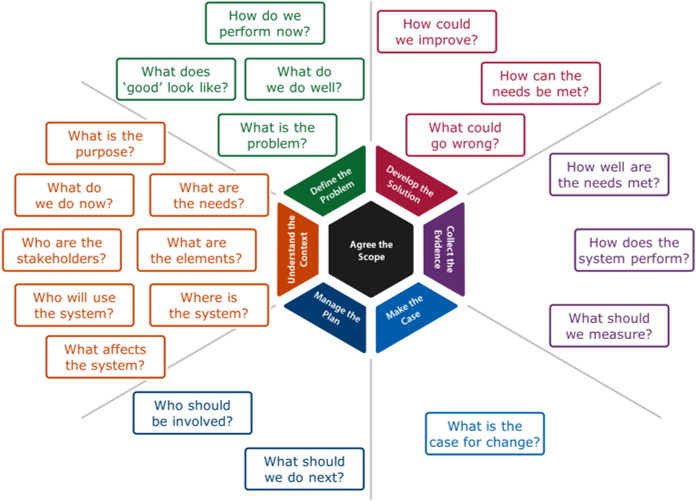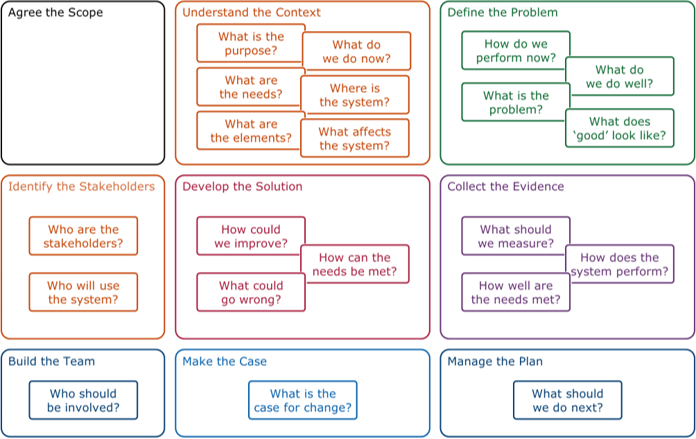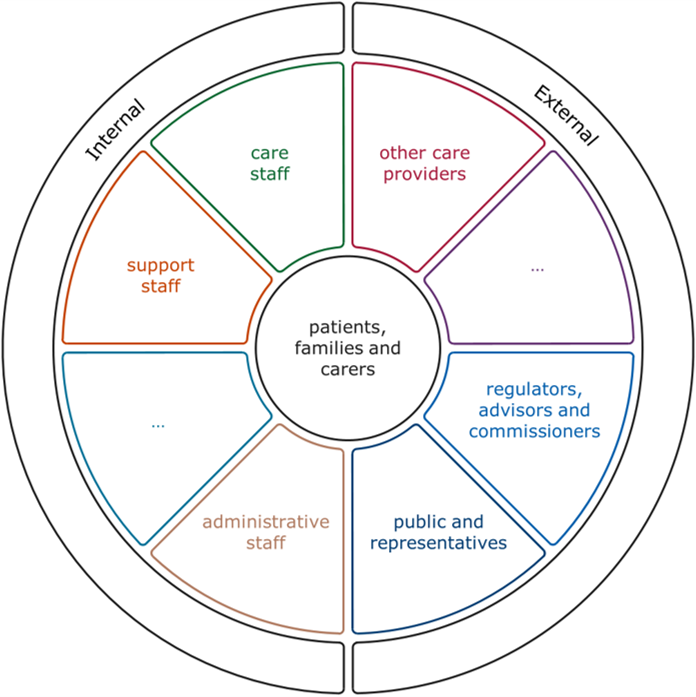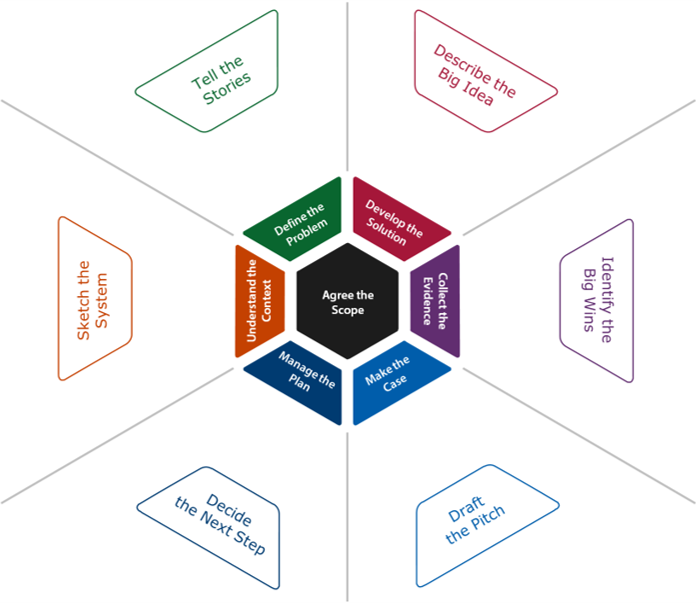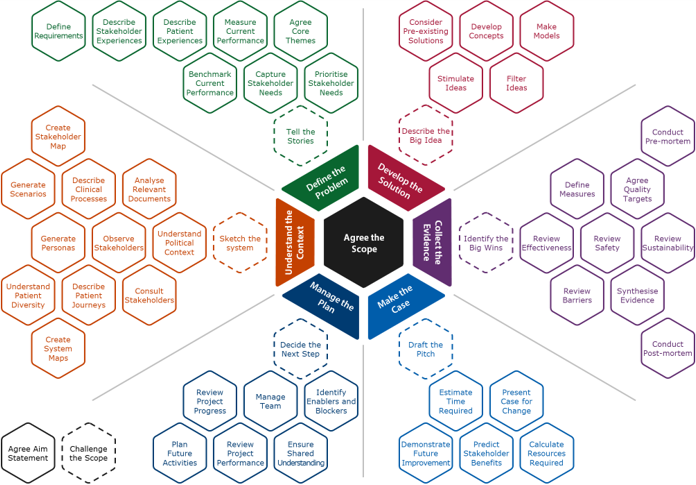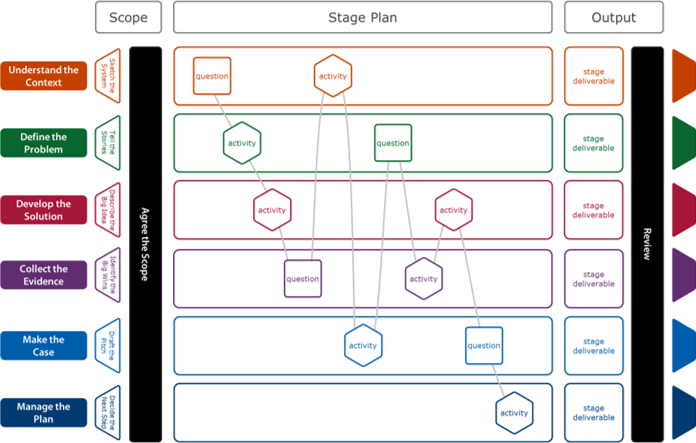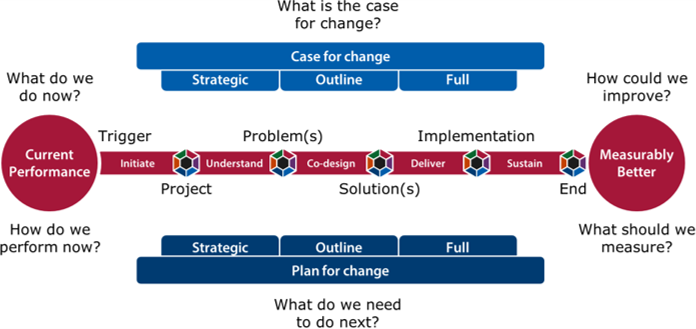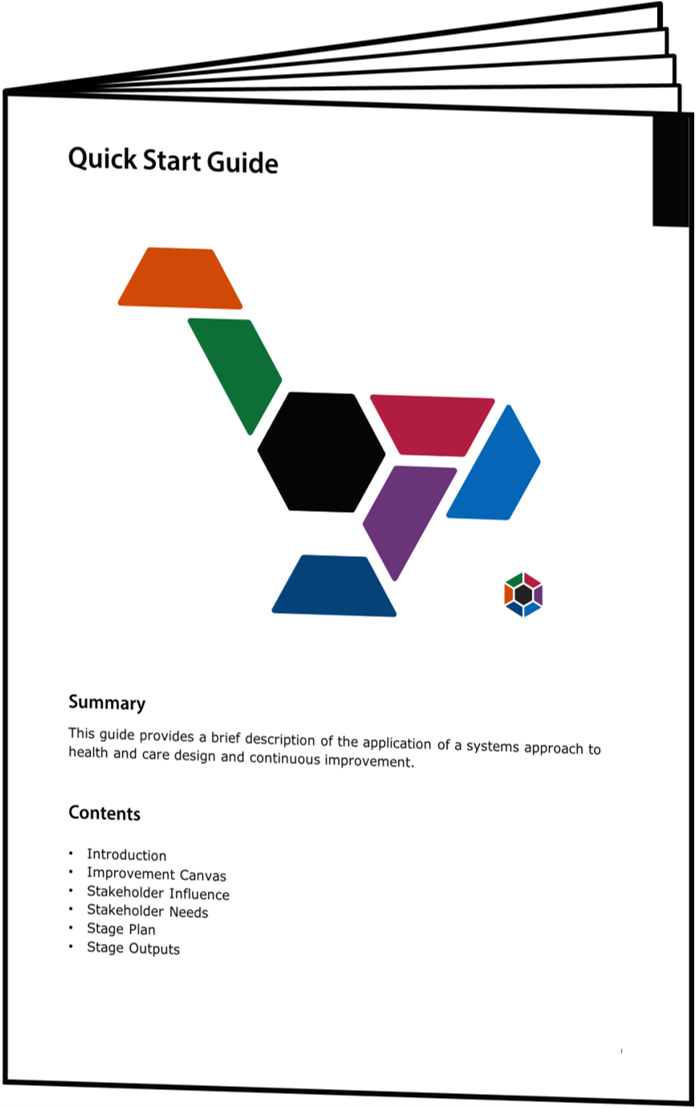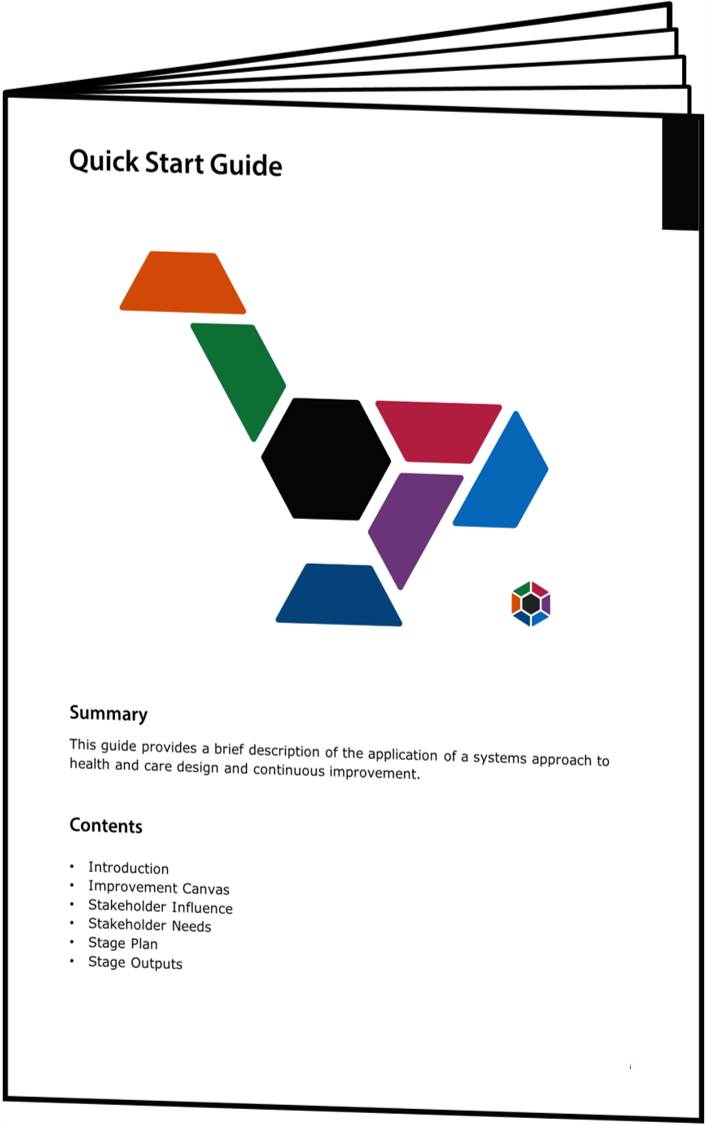Contents
2.1 Introduction
2-11 Understand the Context
2-19 Define the Problem
2-25 Develop the Solution
2-31 Collect the Evidence
2-39 Make the Case
2-45 Manage the Plan
2-51 Agree the Scope
Introduction
In order to answer the questions presented in Engineering Better Care, it is helpful to examine the different activities that will be required to deliver this process. These are likely to include:
- Understand the Context — describes the circumstances or setting that surround a system and all the factors that could influence the system and its improvement.
- Define the Problem — describes the detail of a particular challenge within a system and all the requirements for change necessary to improve the system.
- Develop the Solution — describes a way of solving a particular problem within a system and all the elements of change necessary to improve the system.
- Collect the Evidence — describes the information and all the measures used to evidence the validity of a particular solution(s) to a problem within a system.
- Make the Case — describes the set of facts or arguments in support of improving a system and delivering a particular solution(s) to a problem within the system.
- Manage the Plan — describes a detailed proposal for enabling change to a system and delivering a particular solution(s) to a problem within the system.
- Agree the Scope — describes the context of the improvement envisaged in terms of the extent of the ambition for improvement and the boundary of the system of interest.
These activities will be present throughout the improvement process, where the emphasis given to each one will vary over time, and can be usefully thought of as activity strands. At different stages of the improvement process there will be different targets or deliverables for each of the strands, with early focus more likely on the context and problem and later emphasis on the solution and evidence.
The activity strands can be used to describe a simplified high-level process. An understanding of the context of the current system and its performance leads to the definition of the problem(s), which in turn leads to the development a solution(s), supported by the collection of evidence to demonstrate what is measurably better. A case has to be made and a plan and team managed, bounded by an agreed scope, to maximise the chances of success.
The Improvement Stages section provides more details on the specific activities that might be undertaken within each of the strands.
Improvement Questions
The activity strands are broadly related to the questions of the systems approach and this link may be exploited when planning an improvement programme. The questions provide a way of framing the activities which are undertaken to provide the answers to the questions. A mapping of questions to strands is possible, but should not be seen as definitive.
The majority of the questions relate to the Understand the Context and Define the Problem strands, which focus on the early stages of the improvement process. This is to be expected as the primary emphasis of the systems approach described in this toolkit is the problem-seeking part of an improvement process. The remaining questions then focus on the problem-solving and management parts of the process.
The activities required to answer these questions will likely take the form of a series of exercises, specifically aimed at building team ownership and commitment for a programme of improvement, targeted at the management team or a broader stakeholder team.
Useful toolkit resources: the Questions Map poster and Improvement Questions cards can be downloaded from the Resources section.
Improvement Canvas
The current state of knowledge with regard to any of these strands can be summarised on an Improvement Canvas to allow the improvement team to see a snapshot of the progress towards a measurably better system. At the beginning of the improvement journey the canvas can be used to capture the purpose of the system to be improved, descriptions of service users, details of the improvement team, an initial case for improvement, a working plan, and early or existing information relating to the context, problem, solutions and evidence strands.
These key questions may be used as a prompt to encourage completion of the canvas, with the answers recorded on a blank version of the canvas. The Improvement Canvas is a living document which may be used in electronic form, as a large poster or an interactive worksheet.
The questions may be addressed in sequence or, more likely, out of sequence to encourage people to tell stories and talk about ideas for change before attempting to sketch the system or drafting the case for change. They may be formally presented or woven into the conversation with the team. They may be part of a formal project or be used simply to trigger a follow-on meeting.
In the later stages of the improvement process these early activities will take the form of a recap of the knowledge gained in the previous stage, a reiteration of the scope and direction of the programme and the planning of the now current stage.
Useful toolkit resources: the Improvement Canvas poster and Improvement Canvas worksheet can be downloaded from the toolkit Resources.
Improvement Stakeholders
Successful improvement depends on a wide range of stakeholders and system users who, at any point in time, will have different levels of interest in and power to influence such improvement. They will bring a range of perspectives to any programme and through their action or inaction can enable, actively encourage or frustrate progress.
There is value in characterising stakeholders, in terms of their interest and power, to ensure that they are sufficiently informed, engaged or managed at all stages of an improvement programme. Understanding them and their relative importance is an essential element of managing change.
Stakeholders are defined by their role, needs and reasons for those needs. It is useful to capture this information in the form “ As a … … I need … … so that … ” where these statements provide insights into needs and the rationale for them.
Stakeholders may have multiple and diverse needs and associated rationales, which provides the basis, with their interest and influence, for early conversations to prioritise these needs. Such needs may also vary with time and, therefore, in importance to other stakeholders over time.
Understanding the stakeholders and their key needs facilitates the choice of an effective, and necessarily dynamic, team to deliver improvement.
Useful toolkit resources: the Stakeholder Map poster, Service User cards and Service Stakeholder cards can be downloaded from the toolkit Resources.
Preliminary Activities
An alternative approach to completing the Improvement Canvas is to undertake a series of Preliminary Activities, specifically targeted to ensure the team have a shared understanding of the system. These activities may be undertaken individually or as part of a longer meeting or workshop. While they are identified as individual activities they may also form part of a more integrated narrative exploring the current state of the improvement programme. The particular order of the activities may also vary in response to the state of knowledge at the start of the programme.
The preliminary activities may include:
- Sketch the System — show the relationships between all the elements, people, locations, conditions, tasks and information
- Tell the Stories — communicate stories of patient and stakeholder experiences that bring life to the improvement challenges
- Describe the Big Idea — encourage people to think creatively and describe how the system could be improved
- Identify the Big Wins — identify the big wins and justify the resources required to make the system changes proposed
- Draft the Pitch — create a simple description of the problem, the process that will solve it, and the benefits that might be achieved
- Decide the Next Step — choose the activities most likely to improve the system and enable progress to the next stage gate
- Challenge the Scope — consider different levels of scope and pick the most appropriate level for the project to succeed.
Useful toolkit resources: the Preliminary Activities poster Improvement Activities cards can be downloaded from the toolkit Resources.
Stage Activities
The Stage Activities enable the team to bridge the gap between what is learned from the preliminary activities and what is required to achieve the targets and deliverables for each stage-gate. These activities will in turn be supported by a number of generic tools which provide a range of options for the team in the execution of programme of work. The choice of tools will depend on the particular deliverables required and the competence and experience of the team to use them.
In the first instance, the choice of activities is part of the Decide the Next Step preliminary activity. Subsequently, the choice of process activities and tools for each stage of the programme is decided using the Plan Future Activities stage activity as part of the Manage the Plan strand, where the activities required for each strand of the programme, their detail planning, and their order, will critically depend on the particular challenges.
The Stage Activities are not designed to be rigid, rather they are intended to inspire enquiry across all areas of the improvement process. Each activity can be supported by one or more tools and the same tools may also be used for more than one activity. The task of the facilitator or programme management team is to identify those activities which are essential to the improvement process, and to configure and order them in such a way that they are most likely to deliver an effective improvement programme. The combination of preliminary and stage activities is designed to enable tailoring of the improvement programme to the particular improvement challenge and resource availability, and to allow activities to be combined with exiting improvement approaches and models of change.
Useful toolkit resources: the Stage Activities poster, and Improvement Activities cards and Improvement Tools cards can be downloaded from the Resources section.
Stage Plan
Each stage of the improvement programme can be divided into the seven activity strands, with the preliminary activities or key questions, through the Improvement Canvas, informing not only the scoping of each of these strands, but also identifying the desired outputs for the stage. Additional planning is then required to identify the key questions or activities to be pursued during the programme to deliver these outputs.
Planning involves not only the selection of the activities required to deliver the stage and strand outputs, but also the clustering, sequencing and scheduling of these activities based on the magnitude of the challenge and the resources available. Different programmes or different teams or different triggers are very likely to result in different plans for a given stage. Such plans will also vary considerably across the stages of a programme. In all cases, the plan(s) will need to be used as a guide to the timing of activities, which remains flexible to change as the programme progresses. The Stage Plan is a living document which may be used in electronic form, as a large poster or an interactive worksheet.
Useful toolkit resources: the Stage Plan poster, Stage Plan worksheet and Improvement Activities cards can be downloaded from the Resources section.
Improvement Programme
The improvement programme is made up of a number of stages, each with their own targets and deliverables which can be based on the activity model. These should show progressive development of the targets as the programme progresses, with early focus more likely on context and problem and later emphasis on solution and evidence.
Typical stages of an improvement process are likely to include:
- Initiate — leading to an outline description of the current system (now), a preliminary understanding of the problem, a view of what the future system might look like (better) and a viable plan for initiating an improvement process.
- Understand — leading to a detailed description of the current system (now), a common understanding of the problem, a consensus view of what the future system might look like (better) and a clearly articulated case for changing the system.
- Co-design — leading to a clear description of the future system, based on the iterative design of the system architecture with its elements and interfaces, the evaluation through successive prototyping of its likely behaviour, and a plan for its delivery.
- Deliver — leading to the successful deployment of the new system with the levels of measurement necessary to evidence its success, and acceptance that it achieves appropriate value for its stakeholders.
- Sustain — leading to the continued operational success of the new system along with consideration of further improvement potential or wider deployment.
The addition of the Initiate Stage reflects the specific challenges associated with initiating a viable improvement project.
Useful toolkit resources: the Improvement Programme poster can be downloaded from the Resources section.
Quick Start Guide
A summary of the improvement model and its role in driving improvement is given in a generic Quick Start Guide, designed to facilitate the early planning of an improvement process. This guide accentuates the role of stakeholder analysis, problem structuring using an improvement canvas, and planning in ensuring the right people are solving the right problem.
This guide provides an introduction to the improvement process and further detail can be found in the resources section of the toolkit and in the sections that follow.
Feedback
We would welcome your feedback on this page:
Privacy policy. If your feedback comments warrant follow-up communication, we will send you an email using the details you have provided. Feedback comments are anonymized and then stored on our file server
Read more about how we use your personal data. Any e-mails that are sent or received are stored on our mail server for up to 24 months.



